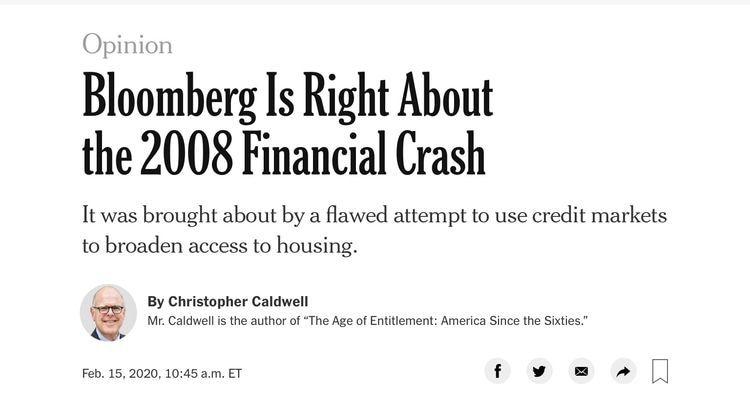Earlier: Based Bloomberg in 2008 on the Minority Mortgage Meltdown
From the New York Times Opinion page:
Bloomberg Is Right About the 2008 Financial Crash
It was brought about by a flawed attempt to use credit markets to broaden access to housing.
By Christopher Caldwell
Mr. Caldwell is the author of “The Age of Entitlement: America Since the Sixties.”
Which I reviewed for Taki’s Magazine.
Feb. 15, 2020, 10:45 a.m. ET
… Certainly there were many elements that brought on the finance crisis, but Mr. Bloomberg correctly identifies the major one: a flawed attempt to use credit markets to broaden access to housing. Studies bear that out.
On Oct. 28, 1992, at the end of an election campaign shadowed by the outbreak in Los Angeles of the deadliest race riots in a quarter-century, President George H.W. Bush signed a Housing and Community Development Act. Mr. Bush wanted to put Fannie Mae and Freddie Mac — the so-called government-sponsored enterprises that purchase, guarantee and securitize trillions of dollars in home loans — behind the cause of fair housing in “underserved areas.”
That meant lowering underwriting standards. …
The economist Viral Acharya and three of his colleagues at the New York University business school saw the first President Bush’s reckless housing plan as the “Rubicon” on the way to the financial crisis that, in the following century, would nearly destroy the world economy under the presidency of Mr. Bush’s even more reckless son. Suddenly the government had room to deal in dangerous mortgages — ones with suspect borrowers and high loan-to-value ratios.
Bill Clinton, elected president in 1992, made this mission his own. Starting in the summer of 1994, he crusaded against the dearth of private housing credit in poor, black, urban neighborhoods. It was he who, without strong evidence, made the incendiary accusation of “redlining.”
Mr. Clinton enlisted and empowered community organizers, using the Community Reinvestment Act, a nearly forgotten piece of legislation from 1977 that gave community groups a way to stymie banks by accusing them of discrimination. He brokered deals. In the quarter-century after 1992, $850 billion in loans was steered through these community groups.
By the time Mr. Clinton left office, the Department of Housing and Urban Development required that low-income loans make up 50 percent of the G.S.E.s’ portfolio. Republicans never objected.
… That brought an astonishing deterioration in the quality of housing assets. By 2007, high-risk mortgages made up 22 percent of the G.S.E.s’ portfolio, up tenfold from a decade before. The economists Atif Mian and Amir Sufi discovered that, between 2002 and 2005, income and mortgage credit growth were “negatively correlated.” The less likely you were to pay off a mortgage, the more likely you were to get one.
The G.S.E.s’ underwriting standards became those of the whole industry. By 2006, 46 percent of new homeowners were making no down payment at all on their houses, and banks had trillions of dollars in loans on their books that would never have been made, absent government pressure. No well-informed accountant thought these loans could survive an economic downturn, and they did not. The politicization of poor people’s mortgages in a single country — the promise to make loans to everyone, as Mr. Bloomberg put it — brought the world to the brink of economic disaster.
… Mr. Rajan linked the financial crisis to the gradual rise of American inequality. …
The result was reckless government extension of credit under both Democratic and Republican leadership. As a remedy for downturns, expanding credit has two practical advantages over government spending. First, it does not bother fiscal conservatives as much. Second, as Mr. Rajan put it: “Easy credit has large, positive, immediate, and widely distributed benefits, whereas the costs all lie in the future. It has a payoff structure that is precisely the one desired by politicians, which is why so many countries have succumbed to its lure.”
Mr. Bloomberg is saying something similar. He did not defend redlining. But that does not mean the idealistic fight against redlining is blameless in the financial shocks of 2008 and thereafter. It is what created the moral pressure — or provided politicians with the moral cover — to follow the destructive loose-credit policies that Mr. Rajan describes.
It is easy to call Bill Clinton a mountebank for raising Fannie Mae’s low-income quota to 50 percent or George W. Bush a fool for raising it to 56 percent. But is there any doubt that they would have faced the same accusations of racial insensitivity that Mr. Bloomberg is now facing had either of them sought to lower it?
I think my 2018 summary of these questions is considerably better. For example, Bush’s 2002-2004 crusade to boost minority homeownership by 5.5 million households by 2010 by watering down traditional credit standards for down payments and income documentation deserves to be mentioned. The problem was less that the government was leaning on lenders to lend more to minorities and “lower-income households” (which in Mortgage-Speak is not the same as what we think of as “low income”) as it was cultivating a mindset in which optimists about minority lending were favored while loosening regulatory restraints on their optimism.
Keep in mind that I’m not saying that the mortgage meltdown was the only cause of the global Great Recession, much as I don’t claim that Pearl Harbor is the only reason that the U.S. fought WWII or that the assassination of the Archduke was the only cause of WWI.
For example, deindustrialization in the U.S. caused a lot of money to pile up in China, Germany, etc., which needed to go somewhere. Investing in mortgages from the rapidly Hispanicizing Sand States seemed like a good idea under the mindset imposed by the Cult of Diversity and Immigration.
In a disaster this large, there are multiple lessons to be learned.
[Comment at Unz.com]













